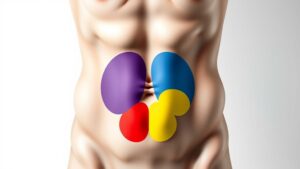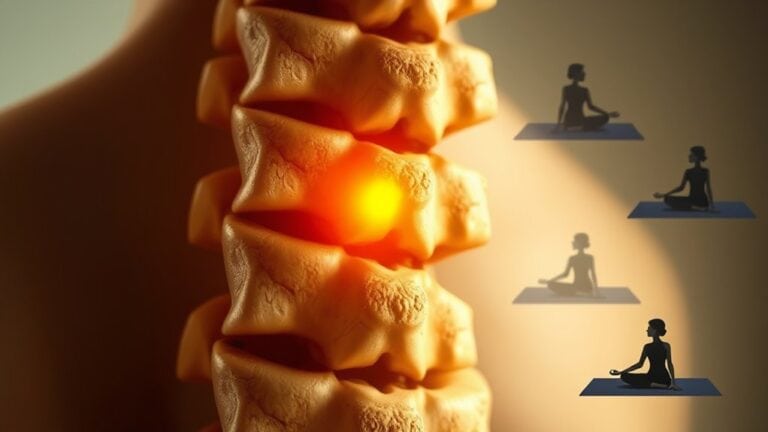Ever pondered why that nagging pain around your belly button won’t just go away? It could arise from a variety of causes, each one unique and often perplexing. From issues like appendicitis to ovarian cysts, it can feel overwhelming not understanding what’s behind that discomfort. Stay with me as we examine the different reasons for that pain, helping you better grasp what could be occurring inside your body.
What Is Pain Around, Above, Below, and Behind the Belly Button?
At times you’re experiencing discomfort around, above, below, or even behind your belly button, it’s easy to feel a bit anxious about what could be causing it. Pain in these areas often relates to different abdominal organs.
For instance, lower pain could hint at urinary tract infections or ovarian cysts in women.
Should you’re feeling symptoms above your belly button, it could signal stomach issues like gastritis or peptic ulcers.
Discomfort behind the belly button can be linked to deeper structures like the pancreas.
Keep in mind, ongoing pain can indicate inflammatory diseases or conditions like bowel obstruction, which definitely requires medical attention.
Always listen to your body; it knows best should something’s not right.
Appendix and Appendicitis
Pain around your belly button can sometimes signal issues linked to the appendix, a small pouch tucked away in the lower right abdomen.
In the event that this pouch becomes inflamed, a condition known as appendicitis occurs, often causing severe abdominal pain that starts near your belly button and shifts to the lower right side.
You could also experience nausea, vomiting, and fever as symptoms of appendicitis. It’s vital to seek medical attention promptly, as a ruptured appendix can lead to serious complications like peritonitis.
Diagnosis typically involves a physical exam, blood tests, and imaging like ultrasounds or CT scans.
Should appendicitis be confirmed, surgical removal of the appendix is usually necessary to prevent further issues.
Urinary Tract Infections (UTIs)
At the time you notice a burning sensation while urinating or a lingering ache in your lower abdomen, a urinary tract infection (UTI) might be the cause. You could experience lower abdominal discomfort, frequent urination, and an urgent need to go. Some individuals might observe cloudy or bloody urine, particularly in case the UTI worsens.
These infections are primarily caused by *E. coli* bacteria and can frequently arise from improper hygiene or sexual activity. In the event it goes untreated, a UTI might lead to intense pain and kidney infections, which display symptoms like fever and flank pain.
It’s vital to identify these signs and symptoms promptly, so don’t hesitate to seek help should you be feeling this way.
Ovarian Cysts and Female Reproductive Conditions
Should you be experiencing pain around your belly button, it might be connected to ovarian cysts or other female reproductive issues.
These fluid-filled sacs frequently cause discomfort on one side of your lower abdomen and can come with symptoms like bloating and pain during your period.
Grasping these conditions is vital, particularly should you be worried about their impact on your fertility.
Symptoms of Ovarian Cysts
Many women experience discomfort related to ovarian cysts, but comprehending the symptoms can make the situation a bit less intimidating. You could notice pelvic pain that feels sharp or dull, often on one side, especially during menstruation or intercourse.
Bloating and that uncomfortable sensation of fullness in your lower abdomen can also signal cysts. Should a cyst rupture, you might encounter sudden, severe pain along with dizziness, fever, or vomiting.
Additionally, irregular menstrual cycles and heavier-than-normal periods can arise from ovarian cysts. Functional cysts, like follicular or corpus luteum cysts, typically resolve on their own within a few menstrual cycles.
Connecting with your body and grasping these symptoms is key to managing this experience.
Diagnosis and Treatment Options
Comprehending the diagnosis and treatment options for ovarian cysts and related female reproductive conditions can make you feel more capable, particularly provided you’re already experiencing discomfort. Your healthcare provider will start with your medical history and a physical examination to check for abdominal discomfort.
Provided cysts are suspected, imaging tests like ultrasounds help identify their size and type. Most ovarian cysts are benign and resolve on their own, but persistent or complex cysts could need hormonal therapy, like birth control pills.
In case you experience sharp pain, nausea, or vomiting from a ruptured cyst, seek emergency care. Endometriosis and pelvic inflammatory disease can also cause issues; both could require specific treatments like surgery or antibiotics.
Impact on Fertility
In the setting of reproductive health, comprehending how ovarian cysts can influence fertility is crucial, especially in the event you’re experiencing challenges in conceiving.
Ovarian cysts, such as those associated with endometriosis and polycystic ovary syndrome (PCOS), can interrupt ovulation, leading to anovulation and diminished fertility chances.
Should you’ve had pelvic inflammatory disease (PID), you could encounter scarring on your fallopian tubes, which can raise the likelihood of ectopic pregnancy and infertility.
Large ovarian cysts might require surgical removal, and that may harm healthy ovarian tissue.
Even recurring functional cysts could interfere with your typical ovulation cycles.
Grasping these connections can assist you and your healthcare provider to investigate effective fertility solutions customized to your needs.
Gastrointestinal Issues: IBS, Constipation, and Peptic Ulcers
Assuming you’re struggling with pain around your belly button, gastrointestinal issues like IBS, constipation, and peptic ulcers might be the culprits.
IBS affects many people, leading to cramping and bloating, often triggered through stress and certain foods.
On the other hand, ongoing constipation can create discomfort as stool builds up, while peptic ulcers might cause burning pain that needs attention.
IBS Symptoms and Triggers
At times you’re tackling the discomfort of IBS, it’s simple to feel swamped by symptoms like chronic abdominal pain and bloating. Grasping your triggers can help ease these feelings. Common ones include:
- Stress and anxiety
- Certain foods (like dairy, gluten, and fatty options)
- Hormonal changes, especially during your menstrual cycle
- Changes in your bowel movements
Irritable bowel syndrome alters how your digestive system functions, leading to uncomfortable sensations.
Up to 45% of those with IBS experience heightened sensitivity in their intestines, making routine activities painful.
Diagnosing IBS often involves evaluating patterns of abdominal pain, particularly in relation to bowel movements.
While IBS can feel overwhelming, it’s essential to recall others share this experience, and options for managing symptoms exist.
Managing Constipation Pain
Managing constipation pain can feel like an uphill battle, particularly while you’re already handling the complexities of IBS. To tackle that discomfort, consider these tips to ease your digestive tract:
| Strategy | Description | Benefits |
|---|---|---|
| Increase Fiber | Aim for 25-30 grams daily | Softens stools |
| Stay Hydrated | Drink at least 8 glasses of water | Prevents hard stools |
| Regular Exercise | Walk 30 minutes daily | Stimulates bowel movement |
| Natural Laxatives | Use prunes, flaxseeds, or psyllium husk | Gentle relief without overuse |
| Medical Evaluation | Consult a doctor for severe pain | Rule out serious conditions |
Menstrual Cramps and Pelvic Inflammatory Disease (PID)
Menstrual cramps can really throw a wrench into your day, especially at the time they strike with sharp, lower abdominal pain right around your belly button.
These cramps often come with nausea and could be made worse by conditions like pelvic inflammatory disease (PID).
Here’s what you should know:
- Menstrual cramps can vary in intensity and duration.
- PID can result from untreated sexually transmitted infections, leading to persistent pain.
- Both conditions may require different treatments like NSAIDs for cramps and antibiotics for PID.
- Severe menstrual pain lasting over a few days could signal other issues like endometriosis.
Hernias: Types and Symptoms
Provided you experience pain around your belly button, especially given that it comes and goes or feels like it’s bulging in that area, you might be handling a hernia.
An umbilical hernia occurs as intestines protrude near your belly button, common in both infants and adults due to factors like obesity or pregnancy.
Meanwhile, incisional hernias occur at surgical sites, causing noticeable discomfort.
Should you feel pain between your belly button and sternum, it could be an epigastric hernia, often filled with fat.
Strangulated hernias are a medical emergency where blood supply is cut off, leading to severe abdominal pain.
Finally, sports hernias affect athletes, resulting from soft tissue tears. Always consult with a healthcare provider for proper assessment.
Ectopic Pregnancy and Endometriosis
While many people mightn’t instantly link their belly button pain to severe conditions, it’s vital to acknowledge that issues like ectopic pregnancy and endometriosis can surface in this region.
- Ectopic pregnancy could result in sharp, one-sided abdominal pain, often on the left side, paired with vaginal bleeding and other signs such as nausea.
- Endometriosis brings about chronic pelvic pain, which may present as sharp cramps, particularly during menstruation or sexual activity.
- Both disorders can induce periumbilical discomfort because of overlapping nerve pathways.
- Ectopic pregnancies demand urgent medical care to prevent life-threatening complications.
If you encounter abrupt or intensifying pain, act swiftly; the emergency room could be your optimal choice.
Grasping these conditions can enable you to seek assistance without delay.
When to Seek Medical Attention for Abdominal Pain
In the situation of abdominal pain, identifying the right moment to seek medical help can make all the difference. Should you experience severe, sudden, or persistent pain, particularly with fever, vomiting, or bloody stools, you need immediate medical attention.
It’s time to consult a doctor whenever your pain worsens over time or limits your daily activities. Localized pain, such as in the lower right quadrant, can signal a common cause of pain like appendicitis, while a rigid abdomen or signs of dehydration require emergency care.
Pregnant individuals should never ignore acute pain, which could indicate serious complications. Should your pain radiate to your back or be paired with jaundice, don’t hesitate; these symptoms need medical care too.




